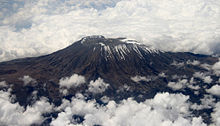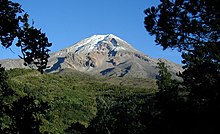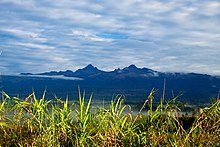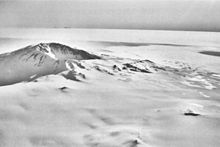
Aconcagua is a mountain in the Principal Cordillera of the Andes mountain range, in Mendoza Province, Argentina. It is the highest mountain in the Americas, the highest outside Asia, and the highest in both the Western Hemisphere and the Southern Hemisphere with a summit elevation of 6,961 metres (22,838 ft). It lies 112 kilometres northwest of the provincial capital, the city of Mendoza, about five kilometres from San Juan Province, and 15 km (9 mi) from Argentina's border with Chile. The mountain is one of the Seven Summits of the seven continents.
The Seven Summits are the highest mountains on each of the seven traditional continents. On 30 April 1985, Richard Bass became the first climber to reach the summit of all seven.

Nevado Ojos del Salado is a dormant complex volcano in the Andes on the Argentina–Chile border. It is the highest volcano on Earth and the highest peak in Chile. The upper reaches of Ojos del Salado consist of several overlapping lava domes, lava flows and volcanic craters, with sparse ice cover. The complex extends over an area of 70–160 square kilometres (27–62 sq mi) and its highest summit reaches an altitude of 6,893 metres (22,615 ft) above sea level. Numerous other volcanoes rise around Ojos del Salado.

Mount Meru is a dormant stratovolcano located 70 kilometres (43 mi) west of Kilimanjaro in southeast Arusha Region, Tanzania. At a height of 4,562.13 metres (14,968 ft), it is visible from Mount Kilimanjaro on a clear day, and is the fifth-highest of the highest mountain peaks of Africa, dependent on definition.
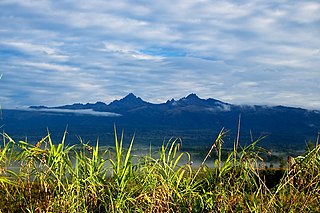
Mount Giluwe is the second highest mountain in Papua New Guinea at 4,367 metres (14,327 ft), and the fifth highest peak on the island of New Guinea. It is located in the Southern Highlands province and is an old shield volcano with vast alpine grasslands. Ancient volcanic plugs form its two summits, with the central peak the highest and an east peak about 2 kilometres (1.2 mi) away at 4,300 m (14,108 ft). Giluwe has the distinction of being the highest volcano on the Australian continent and Oceania, and is thus one of the Volcanic Seven Summits.

Monte Pissis is an extinct volcano on the border of the La Rioja and Catamarca provinces in Argentina, 25 km (16 mi) to the east of the Chilean border and about 550 km (340 mi) north of Aconcagua. The mountain is the third-highest in the Western Hemisphere. Monte Pissis is named after Pedro José Amadeo Pissis, a French geologist who worked for the Chilean government. Due to its location in the Atacama Desert, the mountain has very dry conditions but features an extensive glacier, with crevasses, which is unique in the region.

The Seven Second Summits are the second-highest mountains of each of the seven continents. All of these mountains are separate peaks rather than a sub-peak of the continents' high point. The Seven Second Summits are considered a harder challenge than the traditional Seven Summits.
Jaime Viñals Massanet is a Guatemalan mountaineer, the first person from Central America and Caribbean region ever to climb the Earth's highest peak, Mount Everest, after reaching the summit together with the American Andy Lakpass and the Danish Asmus Noreslet on an expedition from New Zealand organized by Russell Brice, Since then, he became one of the few people to have reached the Seven Summits - the highest mountains of each of the seven (sub-)continents. also he has finished to climb the Seven Islands of the World.
Mount Hagen, named after the German colonial officer Curt von Hagen (1859–1897), is the second highest volcano in Papua New Guinea and on the Australian continent, ranking behind only its neighbour Mount Giluwe which is roughly 35 kilometres (22 mi) to the south-west. It is located on the border between the Western Highlands and Enga Provinces, about 24 kilometres (15 mi) north-west of the city of Mount Hagen which is named after it.
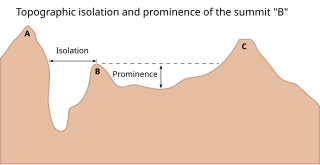
The topographic isolation of a summit is the minimum distance to a point of equal elevation, representing a radius of dominance in which the peak is the highest point. It can be calculated for small hills and islands as well as for major mountain peaks and can even be calculated for submarine summits. Mount Everest, the highest point on Earth, has an undefined isolation, since there are no higher points to reference.

Nevado San Francisco, or Cerro San Francisco, is a stratovolcano on the border between Argentina and Chile, located just southeast of San Francisco Pass. It is considered extinct and is one of the several 6,000 m (19,700 ft) peaks in the area, of which the chief is the Ojos del Salado. It is on the border of 2 provinces: Argentinean province of Catamarca; Chilean province of Copiapo.

Zed "Zeddy" Al Refai is a Kuwaiti climber. He was the first Arab to climb Mount Everest and the 46th person to climb all seven highest summits in the seven continents of the world.
Kalpana Dash was an Indian lawyer and mountaineer. She was the first Odia mountaineer to scale Mount Everest. She scaled Mount Everest on 21 May 2008, along with a team of five members from the United States, Canada and Nepal.
Samina Khayal Baig is a Pakistani mountaineer who climbed Mount Everest in 2013, all Seven Summits by 2014, and K2 in 2022. She is the first Pakistani woman to climb Everest, K2 and the Seven Summits. She climbed Mt. Everest at the age of 21.

Satyarup Siddhanta is a Bangalore-based Indian mountaineer. Satyarup became the youngest mountaineer in the world and the first from India to climb both the Seven Summits and Volcanic Seven Summits on 15 January 2019 at 10:10 pm Chile time. Guinness World Records approved this claim.

Daniel Bull is an Australian adventurer, mountain climber, and professional speaker. He has climbed the Seven Summits and the Volcanic Seven Summits. He also holds the world record for the highest altitude kayaking. He currently works as a motivational speaker.

The Eight Summits is the collective name for the eight highest mountain peaks on each of the seven continents. It is an alternative name for the "Seven Summits" due to different ways in naming the highest mountain on the continent of Australia.


